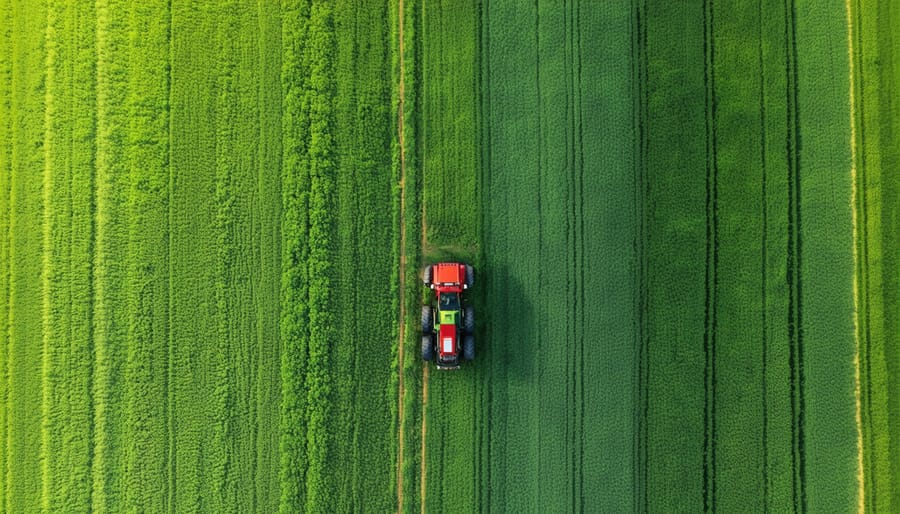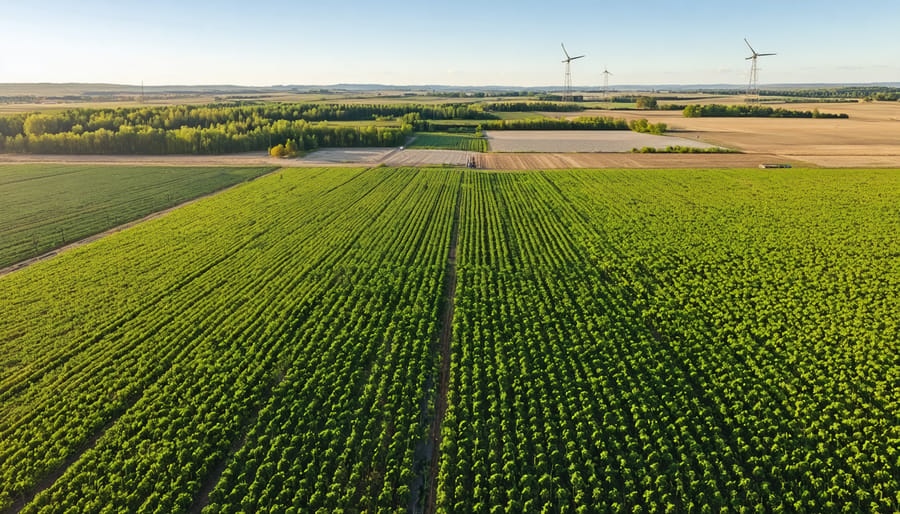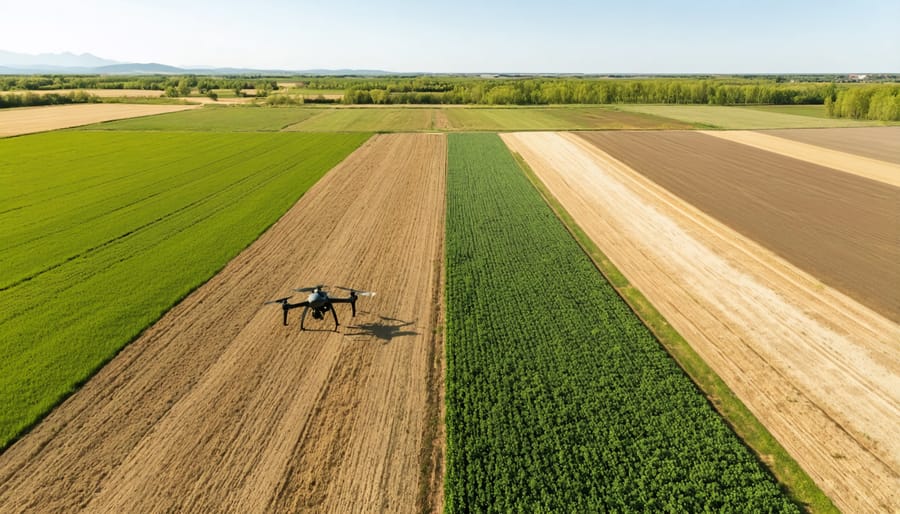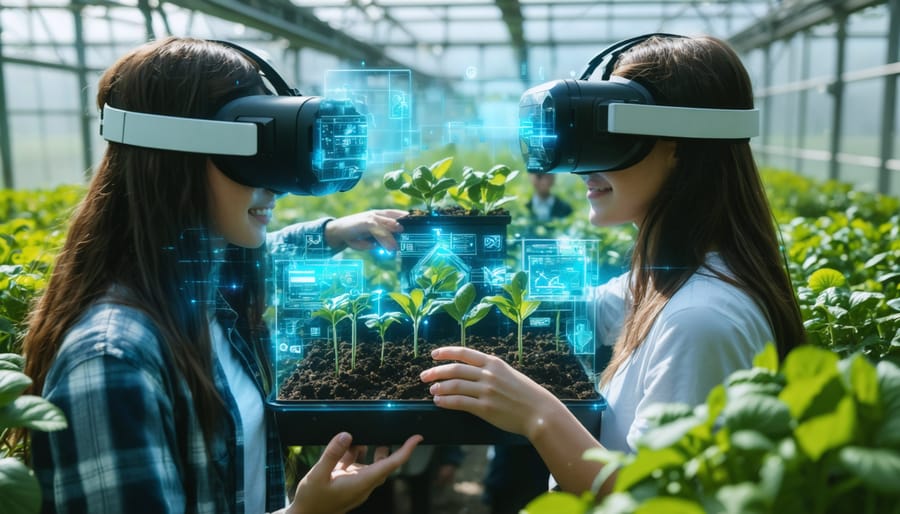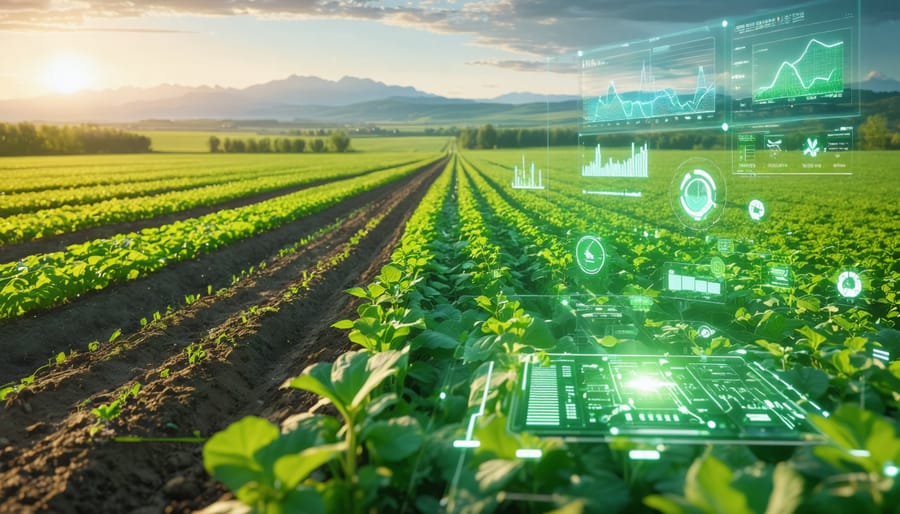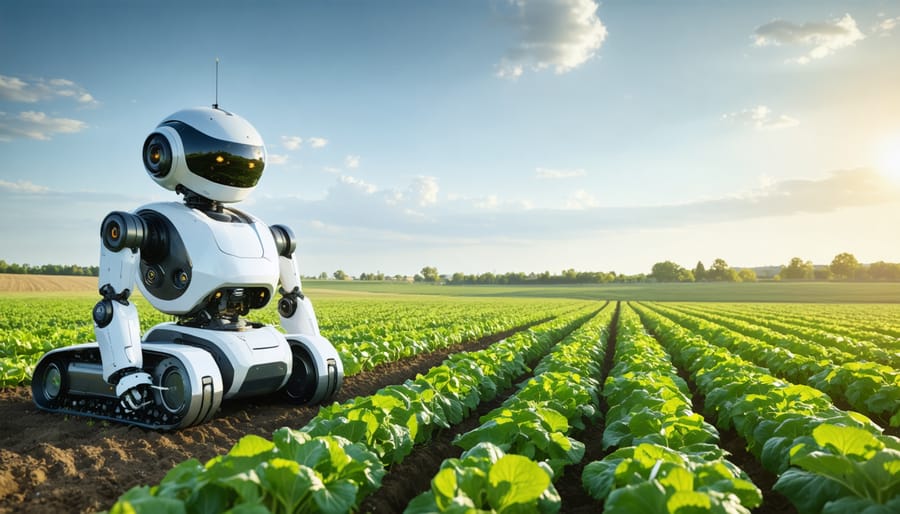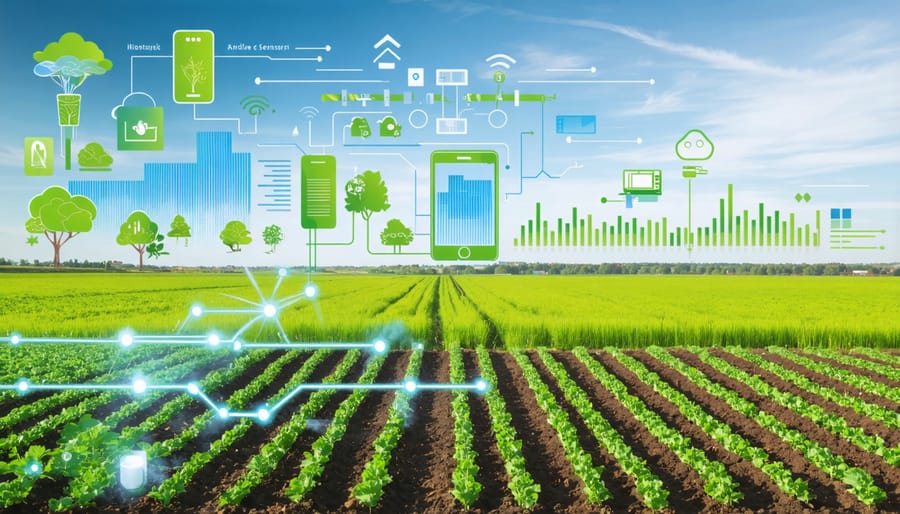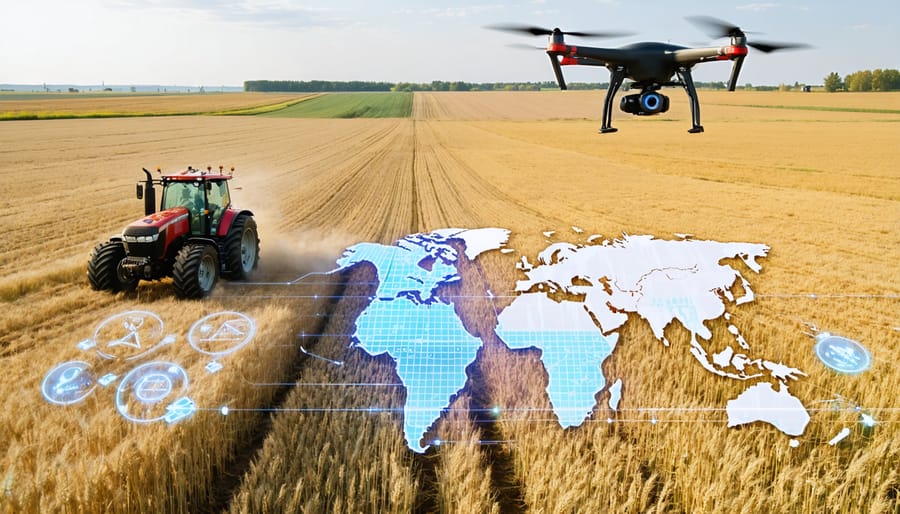Precision farming revolutionizes Canadian agriculture by merging data-driven insights with time-tested farming wisdom. Today’s farmers harness GPS-guided tractors, soil sensors, and drone technology to optimize every hectare, reducing input costs by up to 30% while maximizing yield potential. Across Alberta’s diverse growing regions, from Peace Country’s grain fields to Southern Alberta’s irrigation districts, precision agriculture techniques empower farmers to make field-specific decisions with unprecedented accuracy.
This technology-enabled approach transforms traditional farming practices into a sophisticated system of resource management. Real-time soil moisture monitoring, variable-rate fertilizer application, and automated pest detection systems now allow farmers to treat each field section according to its unique needs. The result: enhanced crop quality, reduced environmental impact, and improved farm profitability.
For Canadian producers facing increasingly unpredictable weather patterns and tightening profit margins, precision farming offers a practical path forward. By combining local agricultural expertise with advanced technology, farmers can make informed decisions that respect both their bottom line and their stewardship of the land. These modern techniques represent not just an evolution in farming practices, but a fundamental shift in how we approach sustainable food production in the 21st century.
The Foundation of Precision Organic Farming
Soil Mapping and Analysis
Modern soil mapping and analysis have revolutionized how Alberta’s organic farmers understand their land. By implementing zone soil sampling techniques, farmers can create detailed nutrient maps that guide precise organic amendments and crop rotation decisions.
Advanced electromagnetic sensors now allow farmers to measure soil conductivity across their fields, revealing variations in texture, moisture content, and organic matter. This technology, combined with GPS mapping, helps identify distinct management zones within each field. Local success stories, like the Morrison family farm near Red Deer, demonstrate how this approach has reduced input costs by 20% while maintaining organic certification.
Portable soil testing kits enable real-time pH and nutrient analysis, while drone-mounted multispectral cameras capture detailed soil health indicators. These tools help organic farmers make informed decisions about cover crop selection and natural amendment application rates.
For best results, experts recommend conducting comprehensive soil mapping every three to five years, with targeted testing in problem areas annually. This systematic approach ensures compliance with organic standards while maximizing soil health and crop yields.

Weather Monitoring Systems
Alberta’s network of automated weather stations provides farmers with real-time climate data essential for precision farming decisions. These stations, positioned strategically across agricultural regions, monitor key parameters including temperature, precipitation, wind speed, and soil moisture levels.
Local farmers can access this data through user-friendly mobile apps and web platforms, enabling them to make informed decisions about irrigation scheduling, frost protection, and optimal timing for field operations. The Alberta Climate Information Service (ACIS) network, with over 350 monitoring stations province-wide, offers particularly valuable hyperlocal weather insights.
Predictive modeling systems integrate historical weather patterns with current data to forecast conditions up to 14 days ahead. These forecasts help farmers plan activities like seeding, spraying, and harvesting with greater confidence. Many Alberta producers are now combining weather station data with soil sensors and satellite imagery to create comprehensive field management strategies.
The University of Alberta’s Agriculture Weather Network provides additional support through specialized crop disease forecasting models, helping organic farmers anticipate and prepare for potential pest and disease pressures based on weather conditions.
GPS-Guided Management for Organic Fields
Variable Rate Application
Variable rate application technology allows organic farmers to precisely distribute amendments and fertilizers based on detailed soil analysis and field mapping. By integrating GPS guidance systems with spreader equipment, farmers can revitalize soil health while optimizing input costs.
Modern VRA systems use prescription maps created from soil testing data, yield histories, and topographical information to automatically adjust application rates as equipment moves across the field. This precision ensures that each area receives exactly what it needs – no more, no less.
For Alberta farmers, this technology has proven particularly valuable when applying compost, manure, and approved organic amendments. Local success stories include the Davidson family farm near Red Deer, which reduced their organic fertilizer costs by 15% while maintaining yields after implementing VRA technology.
To get started with VRA, consider these practical steps:
– Conduct comprehensive soil testing across your fields
– Create detailed field maps highlighting variation in soil types and nutrient levels
– Invest in compatible spreading equipment with GPS capability
– Work with local precision ag specialists to develop application prescriptions
– Monitor results through regular soil testing and yield mapping
Remember that while the initial investment may seem significant, many Alberta farmers report ROI within 2-3 growing seasons through reduced input costs and improved yield consistency.
Precision Weeding Solutions
Modern GPS-guided mechanical weeding has revolutionized organic farming across Alberta and beyond, offering unprecedented precision in weed management while maintaining soil health. These systems combine RTK (Real-Time Kinematic) GPS technology with sophisticated mechanical tools to achieve accuracy within 2-3 centimetres.
Alberta farmer Tom McKenzie from Lethbridge County reports a 40% reduction in labour costs since implementing GPS-guided mechanical weeding on his 800-hectare organic operation. “The precision allows us to get much closer to the crop row than we ever could manually,” McKenzie explains. “We’re seeing better yields and significantly fewer weeds returning the following season.”
These systems typically employ a combination of tools, including finger weeders, torsion weeders, and precision hoes, all guided by automated steering systems. The technology works particularly well for row crops like wheat, canola, and pulses, which are common in Canadian prairie farming.
The initial investment ranges from $30,000 to $75,000, depending on the system’s complexity, but many farmers report reaching ROI within two to three growing seasons through reduced labour costs and improved crop yields. Provincial agricultural programs often offer cost-sharing initiatives to help offset the initial investment.
For best results, these systems should be integrated with other sustainable practices like crop rotation and cover cropping, creating a comprehensive approach to weed management that aligns with organic certification requirements.
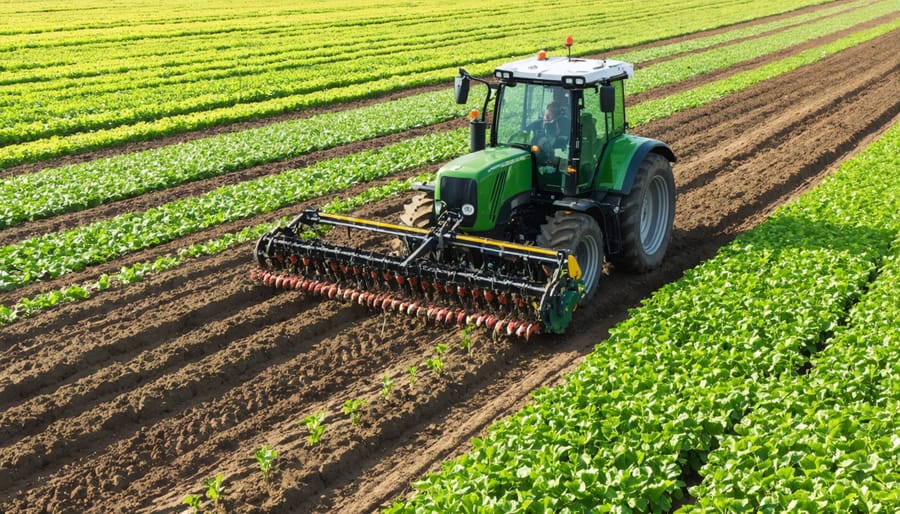
Data-Driven Decision Making
Field Monitoring Tools
Modern field monitoring tools have revolutionized organic farming by providing precise, real-time data while adhering to organic certification requirements. Soil moisture sensors, placed strategically throughout fields, help farmers optimize irrigation schedules and prevent water waste. These sensors can be particularly valuable during Alberta’s unpredictable weather patterns, ensuring crops receive adequate moisture without oversaturation.
Temperature and humidity sensors mounted on weather stations offer crucial microclimate data, helping farmers anticipate frost risks and disease-prone conditions. Many Alberta farmers have found success with drone-mounted multispectral cameras, which capture detailed imagery of crop health without disturbing the soil or applying synthetic materials.
For soil health monitoring, portable electronic pH meters and electrical conductivity sensors provide instant readings while maintaining organic integrity. These tools help farmers track nutrient levels and soil composition throughout the growing season, supporting informed decision-making about organic amendments and crop rotation.
Remote sensing systems, including satellite imagery services, offer broad-scale monitoring of field conditions. When combined with GPS-enabled tablets or smartphones, farmers can create detailed field maps and track changes over time. Many of these tools now integrate with farm management software, creating comprehensive digital records that support organic certification documentation while streamlining daily operations.
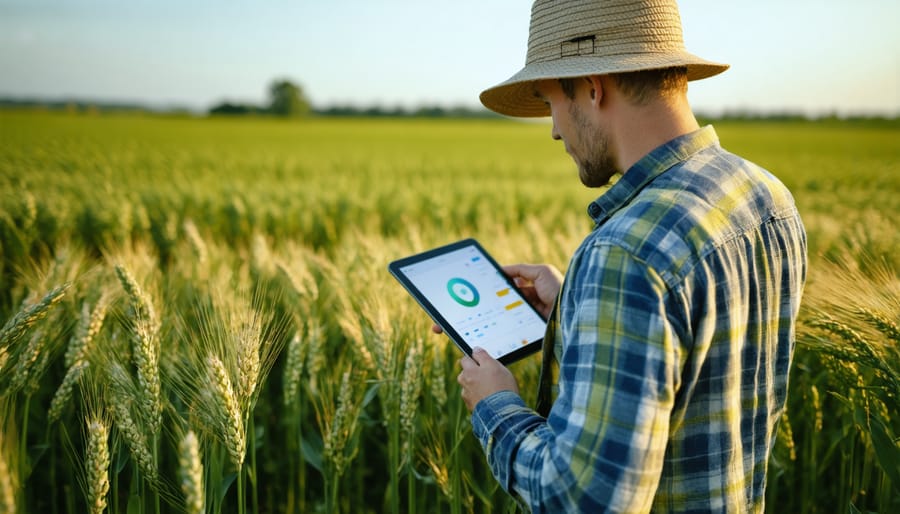
Management Software Solutions
Modern farm management software has become an essential tool for organic farmers across Canada, helping streamline operations while ensuring compliance with Canadian organic standards. These digital solutions offer comprehensive features tailored to our unique growing conditions and regulatory requirements.
Popular platforms like Croptracker and FarmNext provide real-time monitoring of field operations, crop rotation planning, and detailed record-keeping capabilities essential for organic certification. These systems can track everything from seed sourcing to harvest dates, making audit preparation more efficient and less time-consuming.
Many Alberta farmers have found success using management software that integrates weather data with field mapping, helping optimize irrigation scheduling and pest management strategies within organic guidelines. These platforms often include mobile apps, allowing farmers to update records and make decisions right from the field.
Cost-effective options are available for operations of all sizes, with several programs offering free basic versions for small-scale farmers. Local agricultural extension offices often provide training sessions on using these tools effectively, and many software providers offer Canadian-specific support services.
When choosing management software, consider features like bilingual support, compatibility with existing equipment, and the ability to generate reports that meet Canadian organic certification requirements. Many platforms also facilitate collaboration with crop consultants and certification bodies, streamlining the documentation process.
Real Success Stories: Alberta’s Organic Pioneers
Prairie Organic Grain Operation
The Thompson family farm in Camrose, Alberta, offers an inspiring example of precision farming in organic grain production. Operating 2,400 hectares of certified organic land, the Thompsons have successfully integrated modern precision techniques while maintaining strict organic standards.
Their operation utilizes RTK-guided equipment with 2.5 cm accuracy for all field operations, allowing for precise mechanical weed control and targeted organic fertilizer application. Grid soil sampling, conducted every three years, helps create detailed nutrient maps that inform their rotation planning and amendment strategies.
A key innovation on their farm is the use of variable-rate seeding technology, which adjusts seeding rates based on soil conditions and historical yield data. This approach has resulted in a 15% reduction in seed costs while maintaining optimal plant populations across diverse field conditions.
The Thompsons also employ drone technology for crop scouting, helping identify weed pressure points and potential nutrient deficiencies early in the season. This information guides their mechanical cultivation timing and organic amendment applications.
“Precision farming isn’t just about technology – it’s about using data to make better decisions,” explains Sarah Thompson. “We’ve seen our yields increase by 20% over five years while reducing our input costs.” Their success demonstrates how precision agriculture can enhance organic farming operations when thoughtfully implemented with clear objectives and careful monitoring of results.
Mixed Vegetable Farm Technology Integration
At Prairie Harvest Farms in Red Deer County, successful Alberta organic farmers have revolutionized their mixed vegetable operation through strategic technology integration. Using a combination of soil sensors, automated irrigation systems, and drone mapping, they manage 15 different vegetable crops with precision previously thought impossible in organic farming.
The farm’s implementation of IoT sensors has resulted in a 30% reduction in water usage while maintaining optimal soil moisture levels for each crop variety. Their custom-designed sensor network monitors specific zones, allowing for targeted irrigation and fertilization based on individual crop requirements. For instance, their root vegetables receive different moisture parameters than their leafy greens, all managed through a central digital dashboard.
Drone technology provides weekly aerial imagery, helping identify potential pest issues and growth variations across the 40-hectare operation. This early detection system has reduced crop losses by 25% compared to traditional monitoring methods. The farm also employs automated weather stations that integrate with their management software, providing real-time data for frost protection and harvest planning.
The system’s success lies in its scalability and adaptability to different crop needs. Small producers can start with basic sensor arrays and gradually expand their technology integration as their operations grow, making precision farming accessible regardless of farm size.
Implementation Strategy and Resources
Starting your precision farming journey requires a strategic approach and careful resource allocation. Begin by conducting a thorough assessment of your current operations and identifying key areas where technology can make the most impact. Consider partnering with local agricultural extension services or joining farmer networks that focus on organic farming best practices to learn from experienced practitioners.
Start small with one or two precision farming tools, such as GPS guidance systems or soil sensors, before expanding your technological infrastructure. Many equipment suppliers offer rental programs or pilot projects, allowing you to test solutions before making significant investments. The Agricultural Financial Services Corporation (AFSC) and Farm Credit Canada often provide financing options specifically for precision farming equipment.
Essential resources include:
– Reliable internet connectivity for real-time data transmission
– Mobile devices or tablets for field data collection
– Basic weather monitoring equipment
– Soil testing kits and analysis services
– Data management software
Consider allocating 5-10% of your annual operating budget for precision farming implementation. Focus on training your team through workshops and online courses offered by agricultural colleges and extension services. Many precision farming equipment manufacturers provide comprehensive training programs and ongoing technical support.
Remember to document your implementation process, including soil readings, yield data, and resource usage. This information becomes invaluable for future decision-making and helps demonstrate the return on investment. Connect with local precision farming groups and participate in field days to stay current with emerging technologies and share experiences with fellow farmers.
The future of precision organic farming in Alberta shows tremendous promise, with growing adoption rates among local farmers demonstrating its viability. As we’ve explored, the integration of GPS technology, soil sensors, and data analytics has revolutionized how we approach organic agriculture, making it more efficient and sustainable. The success stories from Alberta’s farming community highlight that precision techniques can significantly reduce resource usage while maintaining organic integrity.
Looking ahead, emerging technologies like AI-powered crop monitoring and advanced drone systems are set to further enhance organic farming capabilities. With continued support from agricultural extension services and increasing collaboration within farming communities, Alberta is well-positioned to become a leader in precision organic agriculture. By embracing these innovations while staying true to organic principles, farmers can build more resilient and profitable operations for generations to come. The key to success lies in starting small, learning continuously, and gradually expanding precision farming practices based on individual farm needs and capabilities.

